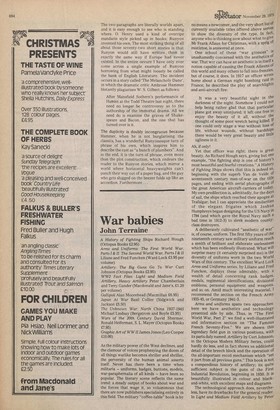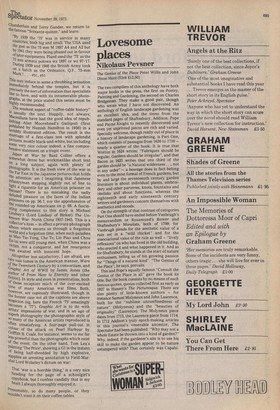Yet that officer was right: there is great beauty. As
Richard Hough says, giving but one example, "the fighting ship is one of historY's most beautiful and fearful creations." A History of Fighting Ships shows that this is indeed sop beginning with the superb Van de Velde of seventeenth century men-of-war on the title pages, and ending with aerial photographs of the great American aircraft-carriers of todaY. My own predilection is, admittedly, for the days of sail, the ships which reached their apogee at Trafalgar; but I can appreciate the similarities of the elegant frigates which Joshua Humphreys began designing for the US Navy in 1794 (and which gave the Royal Navy such a bad time in 1812-3) to sleek modern county class destroyers.
A deliberately cultivated "aesthetic of war is, of course, uniform. The first fifty years of the nineteenth century saw military uniform reach a zenith of brilliant and elaborate uselessness which has been endlessly illustrated. What Will surprise many (it certainly surprised me) is the diversity of uniforms worn in the two World Wars of this century. The excellent Ward Lock Arms and Uniforms series, by Liliane and Fred Funcken, displays these admirably, with a wealth of detail concerning rank badges, medals, regimental identifications, divisional emblems, personal equipment and weapons, and so on. Amid much interesting 'material. recommend the section on the French ArmY 1935-45, or Germany 1941-3.
Amu and uniforms spans two approaches: here we have aesthetics and technology presented side by side. Thus, in "The First World War, Part 2" we find a well-illustrated and informative section on "The Famous French Seventy-Five." We are shown this legendary field gun in various positions, with its parts duly named. Artillery by Curt Johnson, in the Octopus Modern Military Series, could hardly do less, and in fact shows us additional detail of the breech block and the operation of the all-important recoil mechanism which "set it part from all previous guns." This book is not a compendious history of artillery; its quite sufficient subject is the guns of the First Industrial Revolution, beginning in 1850. It is beautifully illustrated in colour and blackand-white, with excellent maps and diagrams.
The technological approach does, nevertheless, have its drawbacks for the general reader. In Light and Medium Field Artillery by Peter Chamberlain and Terry Gander, we return to the famous "Soixante-quinze," and learn: By 1939 the '75' was in service in many countries, both big and small. The USA used the gun as the 75 mm M 1897 A4 and A2 but by 1941 they were being phased out in favour of later equipments. Pland used the '75' as the 75 mm armata polowa wz 1897 or wz 97/17. During 1939 and 1940 the British Army took on a batch as the Ordnance, Q.F., 75-mm Mark I . . etc., etc.
Th. is may induce in some a throbbing sensation Immediately behind the temples, but it is Precisely the sort of information that specialists lIke to have, and with its innumerable photographs at the price stated this series must be highly recommended. The weakest aspect of "coffee-table history" IS usually the text. Happily, not always; Macmillans have had the good idea of republishing Alan Moorehead's Gallipoli (first Published by Hamish Hamilton in 1956) in a lavishly illustrated edition. The result is the marriage of a first-class test with splendid Pictures, mostly black-and-white, but including some very nice colour indeed: a fine comprehensive statement on a tragic event, JuPon at War by Basil Collier offers a somewhat dense but workmanlike short text on a long subject, again with plenty of Photographs. It is the fresh view of the war in the Far East in the Japanese pictures that holds the attention: am I imagining that Japanese infantryman stepping slightly out of line to light a cigarette for an American prisoner on Bataan? There is no mistaking the sadly deluded pleasure on the faces of the Indian Prisoners on pp. 56-7, nor the apprehension of the rounded-up Americans on p. 66. A fascinating complement to this story is Michael Lindsay's (Lord Lindsay of Birker) The Unknown War: North China 1937-1945. This is a collector's item — in effect a private photograph album which escorts us through a forgotten world and a forgotten time, when such paladins aS Mao Tse-Tung, Che Te, Lin Piao and Chou E.ri-lai were still young men, when China was a vtctim, not a conqueror, and her resurgence Was awaited with innocent hope. Altogether less satisfactory, I am afraid, are two vast tomes in the American manner, Wars of the Twentieth Century by a consortium, and Graphic Art of WWII by James Jones (the author of From Here to Eternity and other fiction). In style and even in presentation, both of these recapture much of the over-excited tone of many American war films. Both, however, are copiously illustrated, though in the former case not all the captions are above suspicion (eg. here the French '75' amazingly becomes a '77'). Graphic Art is to do with artists impressions of war, and in an age of superb photography the photographic style of SO many of the American artists reproduced is 'Often unsatisfying. A four-page pull-out in colour of the attack on Pearl Harbour by Griffith B. Coale, for instance, seems to me far less powerful than the photographs which exist of the event. On the other hand, Tom Lea's Painting The Price', showing a GI in the instant of being half-shredded by high explosive, supplies an arresting annotation to Field-Marshal Lord Wolseley's dictum on war: That 'war is a horrible thing,' is a very nice heading for the page of a schoolgirl's copybook, but I confess candidly that in my heart I always thoroughly enjoyed it.
Presumably, so do many people, or they Wouldn't want it on their coffee-tables.



































 Previous page
Previous page